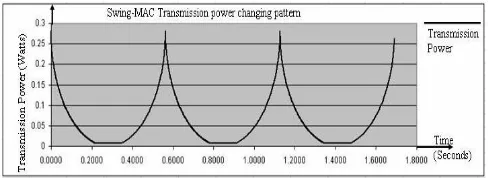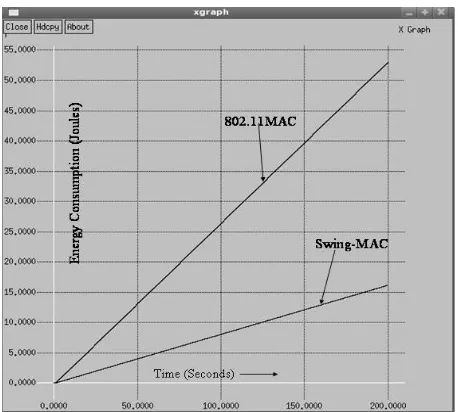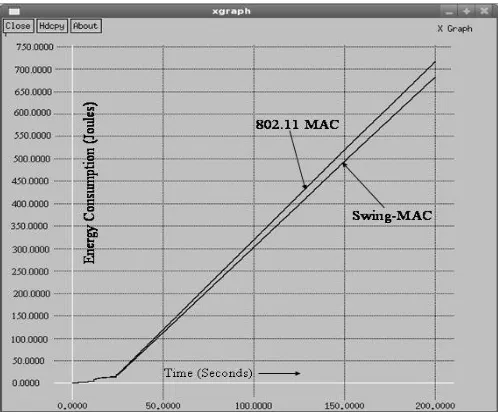Published online October 30, 2014 (http://www.sciencepublishinggroup.com/j/ijssn) doi: 10.11648/j.ijssn.20140204.12
Minimizing power consumption through swinging power
mode in wireless sensor networks
Harish Kumar
1, Prashant Singh
2, Jai Prakash Gupta
11
Department of Computer Science Sharda University, Greater Noida, Uttar Pradesh, India
2
Department of Information Technology, Northern India Engineering College, Delhi
Email address:
harish.kumar.phd@gmail.com (H. Kumar), prashant.ert@gmail.com (P. Singh), jaip.gupta@gmail.com (J. P. Gupta)
To cite this article:
Harish Kumar, Prashant Singh, Jai Prakash Gupta. Minimizing Power Consumption through Swinging Power Mode in Wireless Sensor Networks.International Journal of Sensors and Sensor Networks.Vol. 2, No. 4, 2014, pp. 37-41. doi: 10.11648/j.ijssn.20140204.12
Abstract:
Wireless Sensor Networks have predefined objectives which require them to connect and communicate with othernodes. During communication these nodes transmit and receive data and other control packets. This paper proposes Swing-MAC, a Medium Access Control protocol for energy efficiency designed for wireless sensor networks. It adjusts transmission power level in a swinging mode where transmission power level keeps swinging between minimum and maximum requirement of the network. Minimum and maximum transmission power level is based on the expected coverage between nodes. As transmission power keeps swinging between two intervals on cyclic basis this leads to energy conservation resulting in a longer battery life. Simulation results show that Swing-MAC obtains significant energy savings compared with 802.11 MAC without sleeping.
Keywords:
Transmission Power Control, Wireless Sensor Networks, Medium Access Control, MAC, Energy Conservation,Minimizing Transmission Power, WSN, TPC, Energy Efficiency
1. Introduction
There are continuous advancements in electronics and wireless technology which is creating enough opportunities to create low cost, low power multifunctional wireless sensor nodes that are tiny in size and can communicate in a local area. Wireless Sensor nodes are capable of sensing, measure and gather information from the environment, and as per the network requirements they can send this information to the desired location.
There are some challenges [3][8] of WSNs as applications, control, data, nodes and run-time. Properties of wireless nodes are as they are huge in numbers with low complexity and limited battery life. There are many protocols which are developed to minimize the energy consumption [1][2][3][4][6][12][16]. These protocols focus on the problem of idle listening
[5] and overhearing. These put WSN nodes to sleep [7][10][17] periodically which saves energy consumption. During sleep other nodes are expected to wait for their cycle to be completed so they can become active and start communication. Energy efficient MAC [6] protocol must not only conserve energy but should promise minimization of delay [11] and optimal information extraction [13] [14].
Our Medium Access Control [6] protocol proposes that transmission power keeps swinging between a set of two values which are selected on the basis of minimum and maximum criteria of distance between nodes. As energy keeps swinging between 2 values this protocol is named as Swing-MAC. Process of energy swinging saves energy and throughput remains unchanged.
2. Related Works
to be negligible many times. Switching energy is dependent on the technology used in wireless sensor nodes. Radio used in sensor nodes can be used to save energy between switching cycles. Battery model used in network simulators use linear discharge model which leads to wrong conclusions as switching states depends on battery capacity discharge. Only 6% error in energy consumption of WSN may lead to a shorter network lifetime up to 2 months over the expected network life of 3 years. This research gives a power management technique called Dynamic Power Management with Scheduled Switching Modes (DPM-SSM) [10].in this technique nodes are scheduled to sleep after transmission activity. Battery capacity recovery was analyzed using Differential Hybrid Petri Nets (DHPNs) [10] approach for switching energy of sensor nodes and non linear behavior of battery discharge. This model uses Rakhmatov–Vrudhula battery model and Differential Hybrid Petri Nets (DHPNs) [10] approach for simulating the technique.
Wen-Hwa Liao, Kuei-Ping Shih and Yu-Chee Lee [9] states that in WSN nodes are scattered over an area and they make a network by their own connecting in some fashion. Adjusting energy levels for energy conservation is important for the lifetime of WSN. This research does the estimation of transmission energy by the use of beacon packets [9]. Each node sends some beacon packets at different power level and receiving node estimates the distance. Sensor node estimates the distance through three landmarks. Localization is computed by triangulation method. Based on the availability there can be various types of nodes with different capabilities as low power, low cost, multi-functional nodes. They may have capacity to communicate in long / short distances. Estimation of location has advantages for coverage, deployment, routing, location service, target tracking and rescue.
Suan Khai Chong, Mohamed Medhat Gaber, Shonali Krishnaswamy and SengWai Loke [1] has given a technique that challenges to maximize sensor network lifetime by informing the node about its future operations so future readings can be inferred from previous readings. In this technique some of the sensors are chosen to be switched off for specific time to save battery. Techniques developed in this research are termed as CASE (Context Awareness for Sensing Environments) [1]. The CASE framework has components for building, learning and triggering components for energy conservation in both centralized and in-network WSN configurations. This research has developed a rule-learning algorithm Highly Correlated Rules for Energy Conservation (HiCoRE) [1] algorithm that can learn and discover rules to regulate sensing operations. For CASE Compact this research has evaluated two applications Physical clustering and Query Physical clustering is used to save energy and efficient clustering. Query processing deals with effective and efficient data transmission.
Nikolaos A. Pantazis, Dimitrios J. Vergados , Dimitrios D. Vergados and Christos Douligeris [7] proposes that WSN nodes must listen to idle channel for the prevention of network partitioning. If there is no acknowledgement then nodes are considered as dead nodes and incoming nodes
create their own network. Wireless transceiver listening to idle channel consumes energy equivalent to energy consumption in transmission or reception. It is very large in comparison to a node in sleeping condition. A synchronization schemes that keeps nodes in sleeping mode as long as possible and retain network connectivity would solve the purpose and save energy. Sleep mode synchronization techniques (like S-MAC [17]) create sleep mode related delays. During sleep mode nodes are not able to communicate and this creates delay but saves power. This controls overhearing but introduces sleep-mode delay. This research uses TDMA based scheduling for creating appropriate transmission schedule which saves power and minimizes end to end transmission time between sensors to gateway. Network connectivity is retained through the scheduling of TDMA based wakeup intervals. During these intervals WakeUp [7] messages are transmitted before actual data transmissions. Due to WakeUp scheduling data packets can be delayed for one sleep interval for end-to-end transmission from sensors to appropriate gateway. This technique is advantageous over S-MAC when situation expects high power conservation and low delay simultaneously in network static in nature and requires limited traffic. Disaster detection WSNs expects this situation to keep detecting a rare event for a long time.
3. Proposed Protocol
Every WSN has some defined limits for connectivity. It is assumed that nodes requiring connection would remain within these limits. Transmission power is set to sing within these 2 levels. For smoothening of the power switching level it follows the half circular path described in the algorithm. The reason behind the swinging power levels is that nodes in the WSN are at different distance and require different power levels. Transmitter saves energy by setting different power levels at the variable of time. Bottom energy level is slashed by the minimum power requirement of the network. This helps to keep the nodes active in certain conditions where nodes are at minimum distance specified by the network.
As per our protocol Swing-MAC follows swinging path between two set of values. These values are taken by reference to provide connectivity between 100 meters to 250 meters. Transmission power follows the path described by Swing-MAC Algorithm. TPower_Max=0.2818 and TPower_Min=7.214e-3 are opted for the simulation. Pattern followed by transmission is shown in Fig.1.
3.1. Swing-MAC Algorithm for Changing Energy Pattern
Start
Set SimulationTime=DesiredTime Time=0
/* Time is auto incremented*/ Repeat
Set TPower_Max=UpValue Set TPower_Min=DownValue
X=0
While(X<=2* TPower_Max){ AT Time=X{
Y= TPower_Max – Sqrt(Sqr(TPower_Max) –Sqr(X- TPower_Max)) If(Y< TPower_Min) Y= TPower_Min
}
Increment X by 0.001 }
Until Time <=SimulationTime End
/* TPower_Max, TPower_Min are transmission power in Watt */
4. Simulation Results
Simulation was done in NS 2.35 with following transmission power levels.
Pt_ = 8.5872e-4 Watt // 40 m transmission range Pt_ =7.214e-3 Watt
// 100 m transmission range Pt_ = 0.2818 Watt
// 250m transmission range
4.1. Simulation with 2 WSN Nodes
Fig. 2. Comparison of Energy Consumption with 2 WSN nodes.
Fig. 3. Network Throughput comparison using 2 WSN nodes.
Graphical representation of energy consumption between 802.11 MAC and Swing-MAC is shown in Fig.2. Graph produced by XGRAPH shows energy advantages. Comparison between 802.11 MAC and Swing-MAC protocol shows 69.48507278% energy savings. Throughput between these protocols is shown in Fig.3. Graph produced by XGRAPH shows no changes in throughput compared to 802.11 MAC. Two lines exactly overlap each other showing no change in throughput. Comparison showing energy consumption and throughput is depicted in Table 1.
Table 1. Energy consumption and network throughput with 2 Nodes.
S.N. Protocol Energy Consumption (Joules)
Throughput Achieved 1. Swing-MAC 16.170000 675.25 2. 802.11 MAC 52.990459 675.25
4.2. Simulation with 6 WSN Nodes
Graphical representation of energy consumption between 802.11 MAC and Swing-MAC is shown in Fig.4. Graph produced by XGRAPH shows energy advantages. Comparison between 802.11 MAC and Swing-MAC protocol shows 12.9733317% energy savings. Throughput between these protocols is shown in Fig.5. Graph produced by XGRAPH shows no changes in throughput compared to 802.11 MAC. Two lines exactly overlap each other showing no change in throughput. Comparison showing energy consumption and throughput is depicted in Table 2.
Fig. 5. Network Throughput comparison using 6 WSN nodes.
Table 2. Energy consumption and network throughput with 6 Nodes.
S.N. Protocol Energy Consumption Throughput Achieved 1. Swing-MAC 276.931299 560.385
2. 802.11 MAC 318.214295 560.385
4.3. Simulation with 50 WSN Nodes
Graphical representation of energy consumption between 802.11 MAC and Swing-MAC is shown in Fig.6. Graph produced by XGRAPH shows energy advantages. Comparison between 802.11 MAC and Swing-MAC protocol shows 4.757737803% energy savings. Throughput between these protocols is shown in Fig.7. Graph produced by XGRAPH shows no changes in throughput compared to 802.11 MAC. Two lines exactly overlap each other showing no change in throughput. Comparison showing energy consumption and throughput is depicted in Table 3.
Fig. 6. Comparison of Energy Consumption with 50 WSN nodes.
Fig.7. Network Throughput comparison using 50 WSN nodes.
Table 3. Energy consumption and network throughput with 50 Nodes.
S.N. Protocol Energy Consumption Throughput Achieved 1. Swing-MAC 682.643175 468.237
2. 802.11 MAC 716.743974 468.237
4.4. Summary of Observations
Table 4. Comparison of Energy Consumption and Throughput.
S. N. P r o to co l N u m b e r o f N o d e ss E n e rg y C o n su m p ti o n (N /W ) E n e rg y S a v e d T h ro u g h p u t A c h ie v e d (N /W ) T h ro u g h p u t C h a n g e
1 Swing-MAC 2
16.17
69.49%
675.13 NIL 2
802.11-MAC 52.99 675.13
3 Swing-MAC 6
276.93
12.97%
560.39 NIL 4
802.11-MAC 318.21 560.39
5
Swing-MAC 50 682.64 4.76% 468.24 NIL 6
802.11-MAC 716.74 468.24
Table 4 shows summary of energy consumption with respect to percentage of energy saved using various sets of nodes comparing Swing-MAC against 802.11 MAC. Table 4 also shows throughput consistency for performance.
5. Conclusions
compromises on throughput. This protocol does not put nodes to sleep and is suitable to critical situations where there is a need to transfer continuous data on very small interval gaps. Swing-MAC has shown energy savings for static WSN nodes. Simulation and research is yet to be done for nodes under certain motion criteria. Comparison of this protocol to other protocols can also be done to prove its efficiency. Impact to other network parameters like latency, packet loss, congestion, etc. are also for futuristic research.
References
[1] Suan Khai Chong, Mohamed Medhat Gaber, Shonali Krishnaswamy, SengWai Loke, Energy conservation in wireless sensor networks: a rule-based approach, Knowledge Information Systems, DOI 10.1007/s10115-011-0380-x, Springer-Verlag London Limited 2011
[2] Moshaddique Al Ameen, S.M. Riazul Islam, and Kyungsup Kwak, Energy Saving Mechanisms for MAC Protocols in Wireless Sensor Networks, Hindawi Publishing Corporation International Journal of Distributed Sensor Networks Volume 2010
[3] Jorge M. Soares and Bruno J. Gonçalves, Rui M. Rocha, Practical issues in the development of a minimalistic power management solution for WSNs, Int. J. Sensor Networks, Vol. 8, Nos. 3/4, 2010, Inderscience Enterprises Ltd.
[4] Tao Shu, Marwan Krunz, Energy-efficient power/rate control and scheduling in hybrid TDMA/CDMA wireless sensor networks, Computer Networks 53 (2009) 1395–1408, Elsevier [5] LI Cheng , WANG Kui-ru, ZHANG Jin-long, ZHAO De-xin, LI Wang, Optimization of listening time of S-MAC for wireless sensor networks, The Journal of China Universities of Posts and elecommunications, Issue 5,2009 Elsevier
[6] Bashir Yahya and Jalel Ben-Othman, Towards a classification of energy aware MAC protocols for wireless sensor networks, Wireless Communications And Mobile Computing, 2009 John Wiley & Sons, Ltd.
[7] Nikolaos A. Pantazis, Dimitrios J. Vergados , Dimitrios D. Vergados , Christos Douligeris, Energy efficiency in wireless sensor networks using sleep mode TDMA scheduling, Ad Hoc Networks 7 (2009) 322–343, Elsevier
[8] Jennifer Yick, Biswanath Mukherjee, Dipak Ghoshal, Wireless sensor network survey,Computer Networks, 52 (2008) 2292-2330,Elsevier
[9] Wen-Hwa Liao, Kuei-Ping Shih, Yu-Chee Lee, A localization protocol with adaptive power control in wireless sensor networks, Computer Communications 31 (2008) 2496–2504, Elsevier
[10] Paulo Sérgio Sausen, José Renato de Brito Sousa, Marco Aurélio Spohn , Angelo Perkusich, Antônio Marcus Nogueira Lima, Dynamic Power Management with Scheduled Switching Modes, Computer Communications 31 (2008) 3625–3637,Elsevier
[11] Celal Ceken, An energy efficient and delay sensitive centralized MAC protocol for wireless sensor networks, Computer Standards & Interfaces 30 (2008) 20–31, Elsevier [12] Luiz H.A. Correia, Daniel F. Macedo, Aldri L. dos Santos,
Antonio A.F. Loureiro, Jose´ Marcos S. Nogueira, Transmission power control techniques for wireless sensor networks, Computer Networks 51 (2007) 4765–4779, Elsevier [13] Fernando Ordóñez, Bhaskar Krishnamachari, Optimal Information Extraction in Energy-Limited Wireless Sensor Networks, IEEE Journal on Selected Areas In Communications, Vol. 22, No. 6, August 2004, IEEE
[14] Abdelmalik Bachir, Mischa Dohler, Thomas Watteyne, Kin K. Leung, MAC Essentials for Wireless Sensor Networks, IEEE communications surveys & tutorials, vol. 12, no. 2, second quarter 2010
[15] Issa M. Khalil, ELMO: Energy Aware Local Monitoring in Sensor Networks, IEEE Transactions on Dependable and Secure Computing, Vol. 8, No. 4, July/August 2011
[16] Antonio G. Marques, Xin Wang, Georgios B. Giannakis, Minimizing Transmit Power for Coherent Communications in Wireless Sensor Networks With Finite-Rate Feedback, IEEE Transactions On Signal Processing, Vol. 56, No. 9, September 2008
[17] Wei Ye and John Heidemann, Medium Access Control in Wireless Sensor Networks, USC/ISI TECHNICAL REPORT ISI-TR-580, OCTOBER 2003
[18] http://www.isi.edu/nsnam/ns (official website of network simulator)


